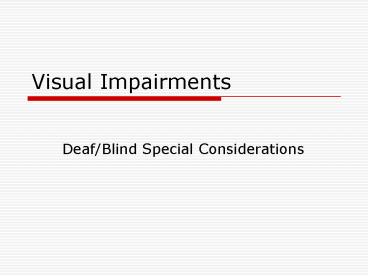Visual Impairments - PowerPoint PPT Presentation
1 / 20
Title:
Visual Impairments
Description:
Esotropia (cross-eyed) most common. Exotropia (wall-eyed) eyes turn out ... Some, if not most, of their needs will be met by others. Attention begins with touch ... – PowerPoint PPT presentation
Number of Views:102
Avg rating:3.0/5.0
Title: Visual Impairments
1
Visual Impairments
- Deaf/Blind Special Considerations
2
Structure of the Eye
3
Vision and Motor Performance
- Acuity-
- Static Visual Acuity-
- Dynamic Visual Acuity-
4
Dynamic Visual Acuity
- Reflects the ability of the muscles of the eyes
(ocularmotor system) to catch and hold an
objects image on the eyes fovea - Improves between 6 and 20 years
- Decreases as speed increases
5
Static Visual Acuity
- Snellen eye chart
- Improvement occurs over the first 4 to 5 years of
life - Birth (20/300 - 20/800)
- Year 1 (20/100 - 20/200)
- Rapid 5 to 7 (20/40)
- Rapid 9 to 10 (20/20)
6
Vision Tests - Infants
- Fixing and following
- Opticokinetic response
- Preferential looking test
- Visual evoked responses (VERs)
7
Vision and Motor Development - Infants
- Developmental delays
- Muscle tone depends partly on visual perception
- visual curiosity elicits movement
- Ex. motor milestones
- How to avoid developmental delays?
- Use various other sensory modalities to elicit
movement, exploration, and play
8
Visual Acuity and Motor Performance - Children
- Motor skill performance
- Exercise
- Age
9
Field of Vision
- Peripheral Vision
- 180 lateral
- 112 vertical
- Adults greater than children
- Key to many movement endeavors
10
Eye Dominance
- Ability of one eye to lead the other in tasks
involving visual tracking and visual fixation - Eye Dominance Test
11
Tracking and Object Interception
- Tracking-
- Horizontal plane-
- Arc-
- Ocular motor system and motor system work
together to track and act
12
Coincidence-Anticipation Timing
- Improves with age
- Greatly influenced by practice
- Greater chances for error in very slow or very
fast moving objects - Implications
13
Visual Impairments
- Legal Blindness/Visual Impairment Definition
- Each state has its own definition
- Blindness Less than 20/200 vision with best
correction, or - Less than 20 degree visual field with best
correction - Incidence - 1 in 3,000
- 25 total blindness
- 25 partial blindness
- 50 can read enlarged type
- Visual Impairment
- Visual impairment that, even with correction,
adversely affects a childs educational
performance - Incidence
- 0.1 of school population or appx. 100,000
students (10k deaf/blind) - 55 males / 45 females
14
Blindness
- Causes
- Heredity (37)
- Anoxia
- Intrauterine infections
- Head trauma
- Retinoblastoma
- Nutrition disorders (vitamin A deficiency)
- Two types
- Cortical - problem along visual pathway
- Retinal - eye structure itself
15
Function and Diseases of the Eye
- Cornea
- Myopia
- Hyperopia
- Astigmatism
- Lens
- Cataract
- Presbyopia
- Anterior Chamber
- Glaucoma
16
Function and Diseases of the Eye
- Eyeball muscles six muscles
- 1-2. Lateral / medial rectus (left/right)
- 3-4. Superior / inferior rectus (up/down)
- 5-6. Superior / inferior oblique (rotate)
- Loss of coordinated movement leads to strabismus
abnormal alignment of the eyes - Esotropia (cross-eyed) most common
- Exotropia (wall-eyed) eyes turn out
17
Identification Nine Warning Signs
- Clumsiness
- Holding materials close to the eyes to see it
- Lack of attention
- Constant need for explanation of what is
happening at events - Extreme sensitivity
- Extreme squinting
- Excessive eye rubbing
- Poking the eyes with fingers or knuckles
- Physical anomalies such as swollen eyes or
strabismus
18
Instructional Strategies
- Eliminate clutter
- Braille labels on items in classroom
- Allow computer to produce work
- Learn some Braille
- Have another student read assignments from books
not available in Braille or on tape - Recognize that some vocabulary words mean nothing
to a person who has never seen them - Use large print with contrasts (if residual
vision)
19
Deaf/Blind Considerations
- Separate category in 1969
- When maternal rubella was causing a significant
increase in the number of babies born with
sensory deficits - Low incidence category
- Defined
- Visual acuity of 20/200 or worse with best
correction, has a chronic hearing impairment so
severe that most speech cannot be understood, and
for whom the combination of impairmentscauses
extreme difficulty in daily life activities
20
Assistance at most basic level
- Must maintain focus to realize
- They exist
- Others exist
- They have needs
- These needs can be met
- They can meet some of their needs
- Some, if not most, of their needs will be met by
others - Attention begins with touch
- Incidental Learning
- Learning must be direct
- Use residual hearing/vision and technology to
assist































